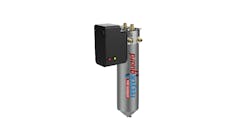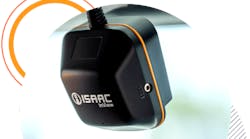In-cab air conditioning (A/C) is a relatively simple vehicle system that is also vital to driver comfort, performance and retention. Unfortunately, in-cab A/C systems can often be overlooked by busy or sometimes inexperienced fleet technicians.
“The biggest issue I’ve been running into lately is a lack of well-trained talent in our industry,” says Jerry Lemon, a longtime mobile A/C system consultant who recently joined Eberspaecher to help lead its initiatives in the A/C product category. Eberspaecher has been in the climate control industry for many years. The company recently acquired Kalori, a French manufacturer of A/C and ventilation systems for commercial and special vehicles.
“Without enough trained technical talent in a shop, maintenance practices often suffer,” Lemon continues. “Some technicians tend to overlook the A/C system during the winter months. But a lack of A/C system maintenance can actually affect the overall performance of the vehicle. In many systems, the compressor is on the same belt that drives all of the other engine systems. If that belt gets trashed, the entire vehicle will shut down.”
The good news is that taking the time to execute basic preventive maintenance measures can go a long way with in-cab A/C system management. Mark Meegan, Bergstrom’s chief strategy officer, vice president of marketing and utility executive, says an important consideration is the environment in which a system operates. Bergstrom is a designer and manufacturer of cab climate systems for commercial trucks, off-highway machines, military vehicles, specialty vehicles and niche automotive markets.
“Dirt and dust can clog filters and degrade system performance,” Meegan says. “If neglected, the evaporator and condenser coils can become corroded or plugged with debris, which can reduce system airflow and impair heat transfer of these components. High underhood temperatures can reduce the life expectancy of all HVAC components, especially belts and hoses. Hoses and fittings can develop refrigerant leaks over time. By following the manufacturer’s recommended maintenance and inspection schedule, most of these concerns can be avoided.”
Don’t neglect the need to inspect
Bergstrom’s Meegan says there are several warning signs that indicate the need for A/C system repair: poor cooling, lack of airflow in the cab and rapid cycling of the compressor. Additionally, the presence of oil spots likely indicates a refrigerant leak. The spots are often covered with dust and found at connection points or where hoses may rub against other objects.
Tim Wagaman, senior product manager of A/C tools and equipment at Robinair, says that because an A/C system is a closed system, fleets typically won’t run into problems until a leak develops and refrigerant begins to escape.
“Visual inspections are really important,” Wagaman says. “When a technician is already under the hood, he or she should take a cursory look at the lines running to and from the compressor, as well as around the engine area, to look for that dirt buildup. Also inspect for significant cracks in hoses.” In addition to A/C equipment, Robinair is a manufacturer of cooling system equipment, leak detectors, transmission service equipment and lubrication service equipment.
With engine-driven A/C systems, components can get damaged from road debris.
“Inspect the condenser to make sure it hasn’t taken a hit from debris or become plugged,” Wagaman says. “Debris can lead to system leaks as well.”
For fleets operating in the cooler northern states, Wagaman says these types of inspections can take place when the vehicle is in for already scheduled preventive maintenance. In southern states, inspections should be done on a more frequent basis, perhaps quarterly. This way technicians can find leaks when they are first developing.
Aside from leaks, there are other A/C-related issues a technician can look for during regularly scheduled preventive maintenance.
“Make sure the compressor is clean and the fins aren’t damaged,” Eberspaecher’s Lemon says. “Also make sure the compressor is mounted securely. I see this a lot. Because of where the compressor is mounted—out in front of the radiator and heat exchanger stack—some hardware can get damaged. Also make sure the air-to-air coolers or other heat exchangers in the system are mounted securely. If they are moving around, that can potentially lead to damage to various connections on the A/C system.”
Filters are another important aspect of a well-functioning A/C system. Lemon stresses the importance of regular inspections and timely replacement.
“Some systems do it all with a single filter package,” he points out. “Other systems split it with a cabin air filter and an external filter. Technicians should understand the system they are servicing and what they need to do. Whatever the case, A/C system filters can be checked when the vehicle is in for regular maintenance.”
Trends, changes and common missteps
According to Chuck Abbott, vice president of sales for CPS Products, one of the most common mistakes technicians make with an A/C system is charging it with too much oil.
“Sometimes a technician assumes that more oil is better,” Abbott says. “Too much oil reduces the cooling capacity of the system. The more oil you have in the system, the more room it takes up and the more it coats the heat exchangers. Technicians should only put back the amount of oil they took out. If they replace a component, it’s important to drain the oil from that component so they know how much they took out.” CPS Products is a manufacturer of HVAC vehicle service equipment including A/C injection, RRR systems and leak detectors.
An extra half-ounce to an ounce of oil shouldn’t hurt, Abbott adds. That said, the more precise, the better. This is especially the case when it comes to refrigerant. In fact, precision is essential.
First of all, technicians need to recognize that A/C systems do not have standard charging amounts. “Technicians need to know how much refrigerant a particular system is to hold,” Abbott says. “That information should come from the OE, so it’s not hard to find.”
R-134a continues to be the predominant refrigerant in heavy duty vehicles. A newer type of refrigerant, R-1234yf, has become increasingly common in passenger vehicles. Abbott wonders when it will start showing up more often in fleet operations. When and if that day comes, fleets will need compatible RRR equipment, leak detection tools and even oils.
“You can use an R-1234yf-compatible oil in an R-134a system, but not vice versa,” Abbott points out.
Eberspaecher’s Lemon suspects that R-1234yf won’t be used on Class 6, 7 or 8 trucks in the foreseeable future. Recent court rulings have delayed the timeframe mandating that refrigerant’s use in heavier duty vehicles.
“Where fleets could start to see R-1234yf is on medium duty trucks and vans,” Lemon says.
There are other types of refrigerants that fleets also need to be aware of. Robinair’s Wagaman says that nowadays, heavy duty vehicles often have two types of A/C systems: an engine-driven system for when the vehicle is running, and a battery-powered auxiliary system that runs when the engine is shut down. Other than the power source, the two systems operate similarly and share many of the same components including a compressor, evaporator, condenser and connection lines.
One big difference can be the refrigerant.
“A diesel engine-powered A/C system typically uses R-134a,” Wagaman says. “An auxiliary system may use R-134a, but could also use R-410a, R-417a or R-404a. Fleets must know if they need to manage and service more than one type of refrigerant. If so, they need processes and equipment that will enable them to do so.”
Tools enhance versatility, efficiency
Robinair manufactures a multi-refrigerant RRR machine. The Robinair 17800C works through a single hookup and is designed for R-134a, R-12, R-22, R-404a, R-407c and many other medium- and high-pressure refrigerant blends.
CPS Products also manufactures a dual-gas RRR machine. The FX3030 is designed to handle both R-134a and R-1234yf.
“Everything flows through a single circuit so you don’t need two compressors and two sets of plumbing,” Abbott explains. “Our dual-gas system is geared to vehicles with up to 10-lb A/C systems.”
Regardless of the type of refrigerant an A/C system is designed to handle, Robinair’s Wagaman says fleets should use equipment that meets the EPA’s 609 requirements for servicing mobile A/C systems.
Looking to the future of A/C system service, CPS Products’ Abbott says telematics could be leveraged to assist technicians with diagnostics. “We are working on a range of Bluetooth sensors and apps,” Abbott says. “The app will say, ‘Put a sensor here and run the vehicle for ‘X’ amount of time.’ Then the app might calculate, for example, that there could be a flow restriction in the evaporator condenser, or maybe that there is a bad orifice tube. We are hoping to have this product to market next year, if not sometime this year.”
Effective leak detection
As Robinair’s Wagaman said, fleets typically don’t run into A/C system issues until a leak develops. That is why catching leaks early on is vitally important. Technicians can either look for oil spots and grime, or utilize an electronic leak detector or UV dye system.
Wagaman says both electronic and UV work well and have their pros and cons. For instance, UV works well — as long as the leak is at a point in the system that is visible. That is why CPS Products’ Abbott says technicians should utilize both methods in order to give themselves the best shot at pinpointing leaks.
With respect to electronic leak detectors, Abbott says fleets should make sure they meet the SAE standard for both R-134a and R-1234yf. Sensor life and battery life are also important.
With respect to UV dyes, Abbott says it’s important to use a dye that is concentrated and long-lasting.
John Duerr, director of engineering for Tracer Products, says dyes should also be solvent-free. And when working with battery-powered auxiliary A/C systems with electronic compressors, it’s important to verify that the dye is compatible. Tracer Products is a manufacturer of vehicle leak detection products.
Duerr says the term “UV leak detection” is somewhat passé now.
“It’s really about fluorescent leak detection,” he says, adding that fluorescent is much more efficient than electronic.
As Duerr explains, with an electronic leak detector, the technician generally has to hold the tool 1/2” from the A/C system components and travel at 2” per second.
“It can be pretty time-consuming to check the entire system,” Duerr says. “With fluorescent dye, on the other hand, the technician simply shines a light over the entire system, following the path of the refrigerant. The technician can cover the entire system very quickly—checking every hose, connection and fitting.”
Again, a high-quality dye is essential. According to Duerr, there are a lot of dyes coming to market that appear to be effective. But the dye is actually diluted down to nothing and doesn’t provide the performance a fleet needs.
“If it’s cheap, there probably isn’t much fluorophore in it,” Duerr says. “Then it won’t be very bright and you won’t be able to pinpoint those leaks.”
The other piece to an effective UV/fluorescent leak detection system is the light source. CPS Products’ Abbott says fleets should use a light in the 400-nm range in order to create the proper reflection.
Duerr says there are huge quality discrepancies on the market when it comes to leak detection lamps. Just like with a dye, fleets shouldn’t go “cheap.”
“We make sure the wavelength of our lamp matches what the dye needs,” Duerr explains.
Aside from the ability to efficiently and cost-effectively pinpoint A/C system leaks, there’s another reason Duerr is such a proponent of fluorescent leak detection.
“Once you put the dye into the system, it’s there for the life of the system unless you change out the oil for whatever reason,” Duerr says. “That’s what makes dye such a great preventive maintenance tool.”
Vigilant inspections, leak detection and preventive maintenance go a long way in ensuring a long, productive life of an in-cab A/C system. Bergstrom’s Meegan says there are other things both technicians and drivers can do to ensure reliable system performance.
“Always keep the cab as clean as possible,” Meegan recommends. “This includes keeping paper and debris picked up, and regularly sweeping or blowing the dirt out of the cab with compressed air.
“The receiver drier should be changed anytime the A/C system is opened up to the ambient air,” Meegan continues. “In addition, many manufacturers recommend changing the receiver drier annually.”
For battery-powered auxiliary systems, Meegan says many truck owners have installed rooftop solar panels as an effective measure to improve battery health and extend HVAC system runtime.
“Bergstrom Solar Energy Systems can extend battery life by up to 200 percent, and reduce the frequency of DPF cleaning, oil changes and engine overhauls,” Meegan says. “Along with reduced maintenance costs, the systems also save fuel and reduce asset downtime.”




